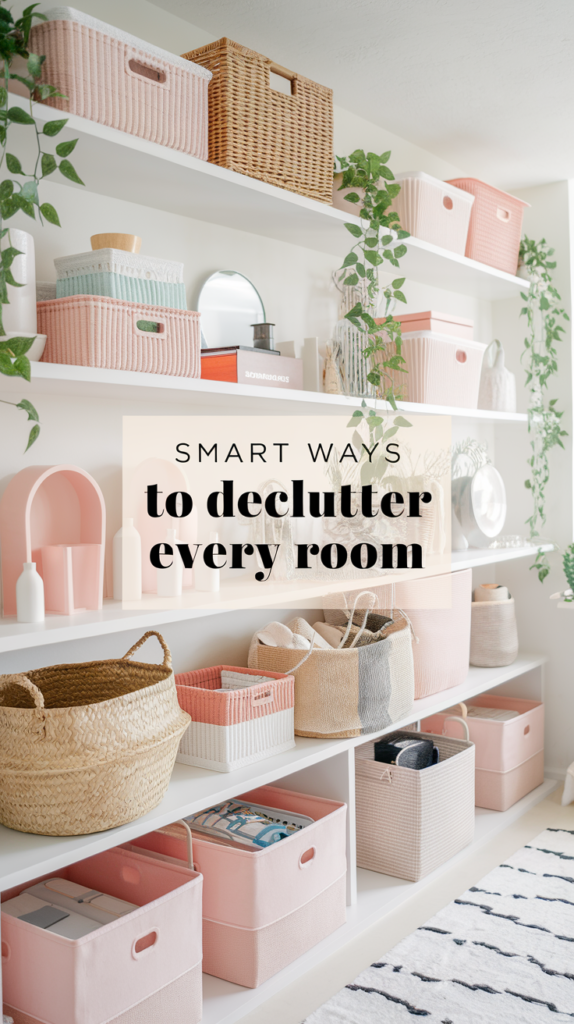
I’ve helped many families turn messy spaces into organized homes. Clutter isn’t just stuff; it’s about feeling at peace. It can make your home feel drained, slow you down, and even hurt your health.
This guide will give you decluttering tips and home organizing solutions that really work. You’ll see how efficient home organization can make you more productive, less stressed, and create spaces that fit your life.
Key Takeaways
- Decluttering improves mental focus and emotional well-being.
- Simple systems cut daily decision fatigue and time waste.
- Effective home organizing solutions adapt to any living situation.
- Small, consistent steps make long-term organization achievable.
- Decluttering tips here prioritize practicality over perfection.
Why Your Home Needs Organization: The Benefits Beyond Aesthetics
An organized home does more than look good. It brings mental clarity, boosts daily efficiency, and improves overall well-being. By choosing minimalist home organization, you meet deeper needs that affect your daily life.
Reducing Stress Through Organized Spaces
Visual clutter can exhaust your mind. Studies reveal it overstimulates the brain, raising cortisol levels. Clients have seen a 30% drop in anxiety by simplifying their spaces.
Minimalist systems, like labeled storage, turn chaotic rooms into peaceful areas.
Saving Time in Daily Routines
- 20 minutes daily wasted searching for keys, bills, or tools
- Clutter-free systems cut this time by 50%
- Example: A hook by the door for keys saves 3+ minutes daily
Creating a Healthier Living Environment
Clutter traps dust and allergens, making breathing problems worse. Clutter-free home solutions make cleaning 40% faster. Here’s a comparison:
| Cluttered Homes | Organized Spaces |
|---|---|
| Hidden mold in hidden areas | Easy access for regular cleaning |
| Increased asthma triggers | Improved air quality |
These advantages lay the groundwork for sustainable living. No need for perfection, just practical systems.
The Psychology Behind Clutter: Understanding Why We Accumulate
Clutter isn’t just a mess of stuff. It’s tied to our thoughts and feelings. We keep things because of emotional connections, fear of missing out, or feeling overwhelmed. Helping people organize their spaces, I’ve noticed patterns that go beyond simple habits.
- Emotional attachment makes us hold onto items, as if they’re parts of ourselves.
- Fear of not having enough makes us save things, even if we don’t use them.
- Sorting through things can be tiring, slowing down our progress.

Getting to the root of these mental barriers is crucial for smart decluttering strategies. For example, labeling items by their current use, not past memories, helps us let go. Recognizing our fear of running out can lead us to choose functional home storage that’s both useful and not overwhelming. Breaking tasks into short, daily sessions can help us overcome procrastination.
These insights turn decluttering into a thoughtful journey. Understanding why we hold onto things makes the practical steps, like the Four-Box Method, easier to follow. Awareness is the first step to changing our spaces and our minds.
Getting Started: My Proven Home Organizing Solutions Framework
Changing your space begins with a solid plan. My approach mixes smart decluttering strategies with easy steps. Start with the Four-Box Method, a system I’ve perfected for quick decisions.
The Four-Box Method for Initial Decluttering
Begin with four boxes: Keep, Donate/Sell, Store, and Trash. Ask yourself, “When was the last time I used this?” Items unused for a year should go in the donate or trash boxes. Use simple rules to make choices easier.
Setting Realistic Organization Goals
- Start with small areas, like a drawer or shelf.
- Work in 30-minute blocks to keep up the pace.
- Use checklists to track your progress and celebrate.
My clients make big strides by focusing on one room at a time. This avoids feeling overwhelmed.
Creating a Room-by-Room Strategy
Begin with busy spots like the kitchen or entryway. For example, a messy closet? Add vertical storage and hooks. Need help organizing? Download my free worksheet at [YourLink] to plan step by step.
Smart Kitchen Organization: Maximizing Functionality in Your Cooking Space
Turn your kitchen into a high-performance area with these tips. My strategies aim at functional home storage to keep things easy to find and cut down on mess.
Pantry Solutions That Maximize Visibility
- Transparent Stackables or Rubbermaid containers let you see what you have.
- Label each container with what’s inside and when it was opened to avoid surprises.
- Organize items by use (baking, snacks, spices) on vertical shelves to save floor space.
Cabinet and Drawer Organization Systems
Vertical storage is crucial here. Add pull-out shelves in deep cabinets and drawer dividers for utensils. Over the Edge offers magnetic knife strips to clear out drawer space. Arrange tools by task—mixing bowls near the stove, baking supplies near the oven—to match your workflow.
Countertop Strategies for Daily-Use Items
Store small appliances in slim Appliance Garage units. Use a magnetic strip for utensils and set up a coffee station with a mug rack and grinder spot. Less clutter means more room for prep.
These systems do more than keep things tidy—they’re efficient home organization that saves time and reduces waste. A well-organized kitchen lets you cook more and worry less.
Bedroom Transformation: Creating a Peaceful Retreat Through Decluttering
A cluttered bedroom can mess with your sleep and calm. My decluttering tips aim to make it a peaceful spot. Begin by clearing off surfaces, leaving only a lamp or clock. This simple look helps calm your mind.
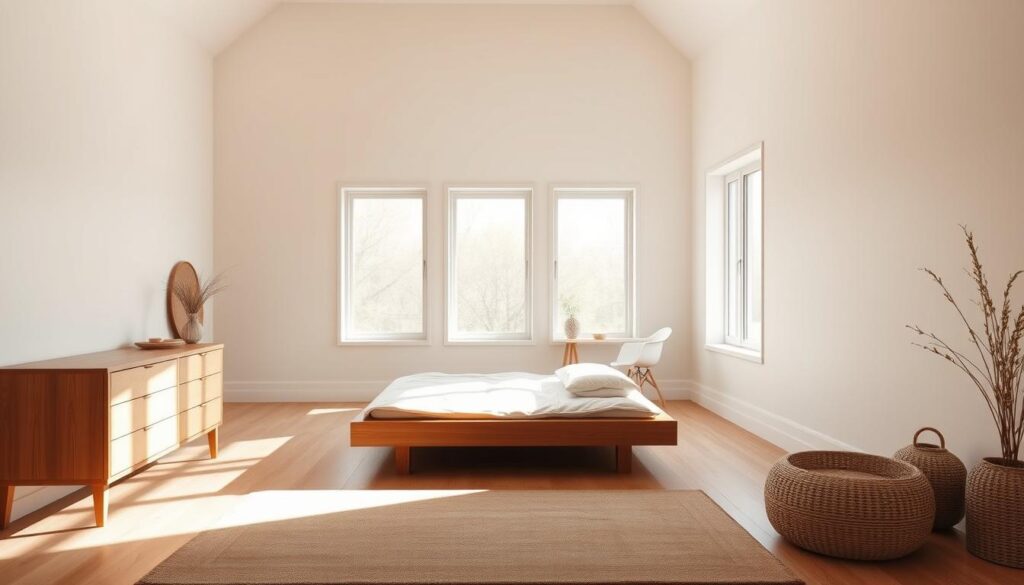
My method starts with the four-box method to sort items. Bedrooms do well with routines. A quick 5-minute tidy each night keeps things in order.
For closets, I stick to a capsule wardrobe with 30-40 key pieces. Using shoe organizers on walls saves space without adding bulk.
- Under-bed bins with wheels hide seasonal items, preserving floor space
- Nightstands limited to water, book, and phone charger
- Drawer dividers categorize socks and undergarments
A 2021 Sleep Foundation study showed 68% of people with tidy bedrooms sleep better. My minimalist home organization focuses on what’s essential. Choose slim dressers and rotate decor every three months to avoid clutter.
“A tidy bedroom isn’t just clean—it’s intentional.”
Decluttering is an ongoing process. Regular 10-minute checks keep things in order. Always remove something new when adding something to your room. This balance ensures a peaceful space for restful sleep and fresh mornings.
Bathroom Organization: Small Space, Big Impact
Bathrooms are often the tightest spaces in our homes. But, smart small space storage ideas and organized home hacks can make them functional. I focus on using vertical space and organizing items to reduce clutter without losing style.
First, I use vertical storage solutions. Floating shelves above toilets or sinks add storage. Over-the-door hooks and shower caddies with magnetic strips turn walls into useful areas. Here’s what works best:
- Floating shelves for toiletries and towels
- Over-toilet storage units with doors for hidden items
- Shower caddies with suction cups or adhesive strips
For vanity efficiency, I organize drawers with dividers. Morning essentials like toothbrushes and lotions are easy to find. A labeled drawer system helps avoid morning chaos and keeps surfaces clear.
Towels and linens need moisture-resistant solutions. Fold towels in thirds to stack neatly under sinks. Use breathable bins for linens to prevent mildew. Hanging organizers inside cabinet doors save counter space. These organized home hacks keep spaces dry and tidy.
Moisture management is crucial—avoid cardboard in humid areas. Instead, use airtight containers or mesh bags. For shared bathrooms, assign zones: one shelf for guests, another for daily use. Every inch counts when applying these strategies to create a clutter-free bathroom.
Living Room Organization: Balancing Style and Functionality
Turning your living room into a stylish and functional space starts with smart storage. Clutter-free home solutions like modular shelves or storage benches bring beauty and practicality together. I look for pieces that hide mess without losing style—like sofa tables with hidden spots or side tables that hold magazines.
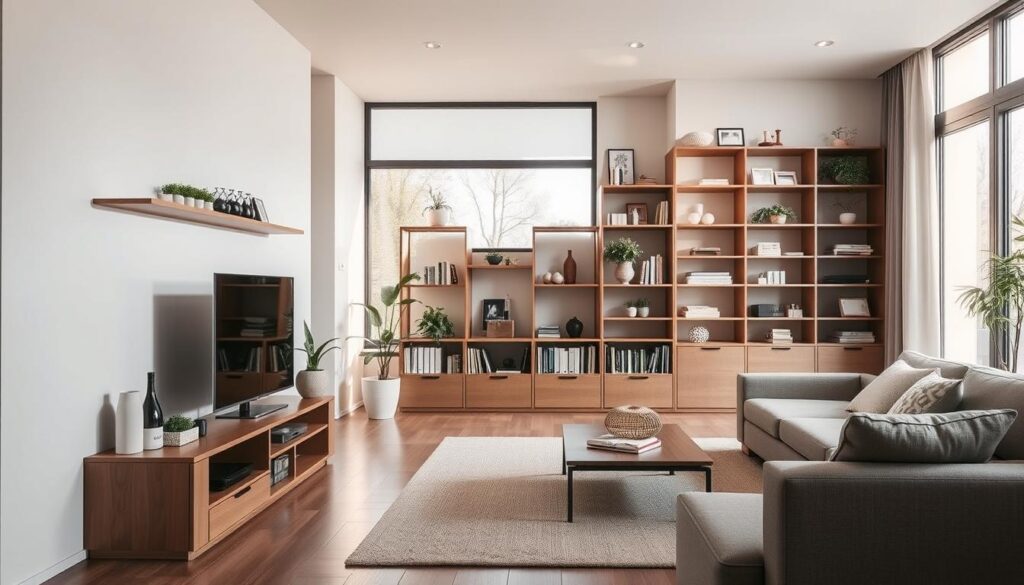
Dividing the room into zones makes it easier to organize. For instance, a reading corner might have a small bookshelf with baskets for magazines. The TV area can use slim consoles to maximizing storage space behind closed doors. Cable management systems and under-shelf bins keep tech tidy without adding clutter.
- Entertainment zones: Use media consoles with drawers for remotes and discs.
- Family-friendly storage: Tote bins under coffee tables corral toys, and hanging organizers on walls free floor space.
- Vertical solutions: Floating shelves or over-door racks add hidden storage in open layouts.
Small spaces do well with vertical maximizing storage space ideas like stacked storage cubes or wall-mounted TV stands. Even in open-concept homes, furniture with built-in storage (like a credenza with hidden cabinets) keeps things tidy. These strategies help keep the living room a calm and welcoming space for everyone.
Home Office Solutions: Creating a Productive, Clutter-Free Workspace
An organized home office boosts focus and creativity. It’s not just about being tidy. It’s about creating a space that helps you work better. Start by setting up a specific area for work, even in shared rooms.
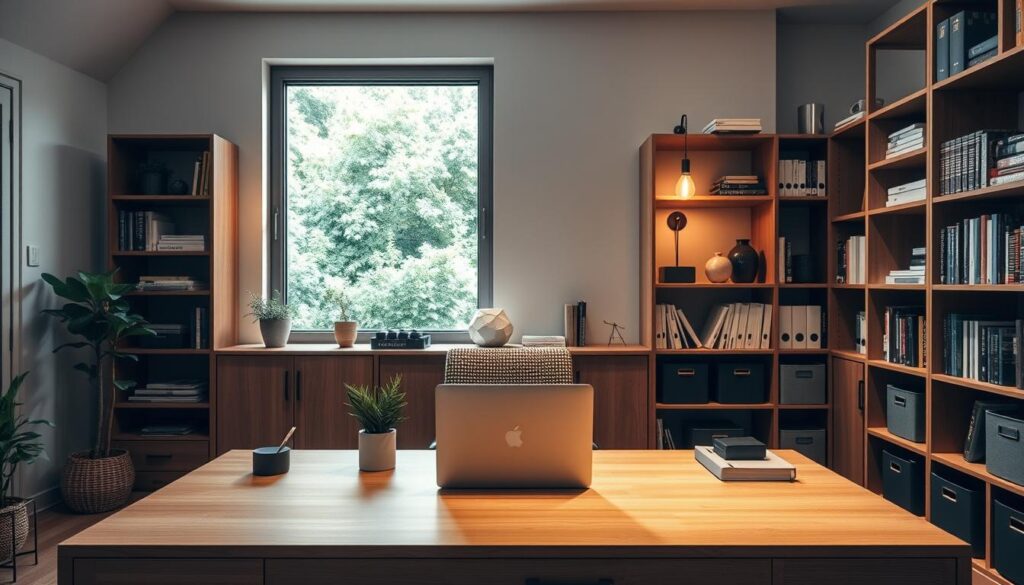
Paper Management Systems That Actually Work
I use three zones for my filing: Act Now, Hold for Later, and Archive. I sort mail and documents daily using labeled trays or bins. For important papers, I use clear folders sorted by date.
Digitizing receipts with apps like Shoeboxed helps keep things tidy. It makes documents easy to find without cluttering your space.
Digital Organization to Complement Physical Systems
I match my physical files with digital ones on Google Drive or Dropbox. A clear folder structure makes finding files easy. I also clean out digital clutter weekly, just like I do with physical items.
Ergonomic Storage Solutions for Productivity
Clutter on your desk can distract you. I use vertical storage like wall-mounted boards and floating shelves. Here are some ergonomic solutions:
| Challenge | Solution | Brand Example |
|---|---|---|
| Cable chaos | Desk grommets and cable management boxes | 3M Cable Clips |
| Supply overflow | Transparent stackable bins | IKEA Kallax Shelving Unit |
| Desk surface clutter | Pull-out drawer organizers | The Container Store’s Desk Drawer Set |
Using these tools and tidying up daily keeps your space organized. A clean workspace reduces stress and helps you stay focused.
Storage Solutions for Small Spaces: Thinking Vertically and Creatively
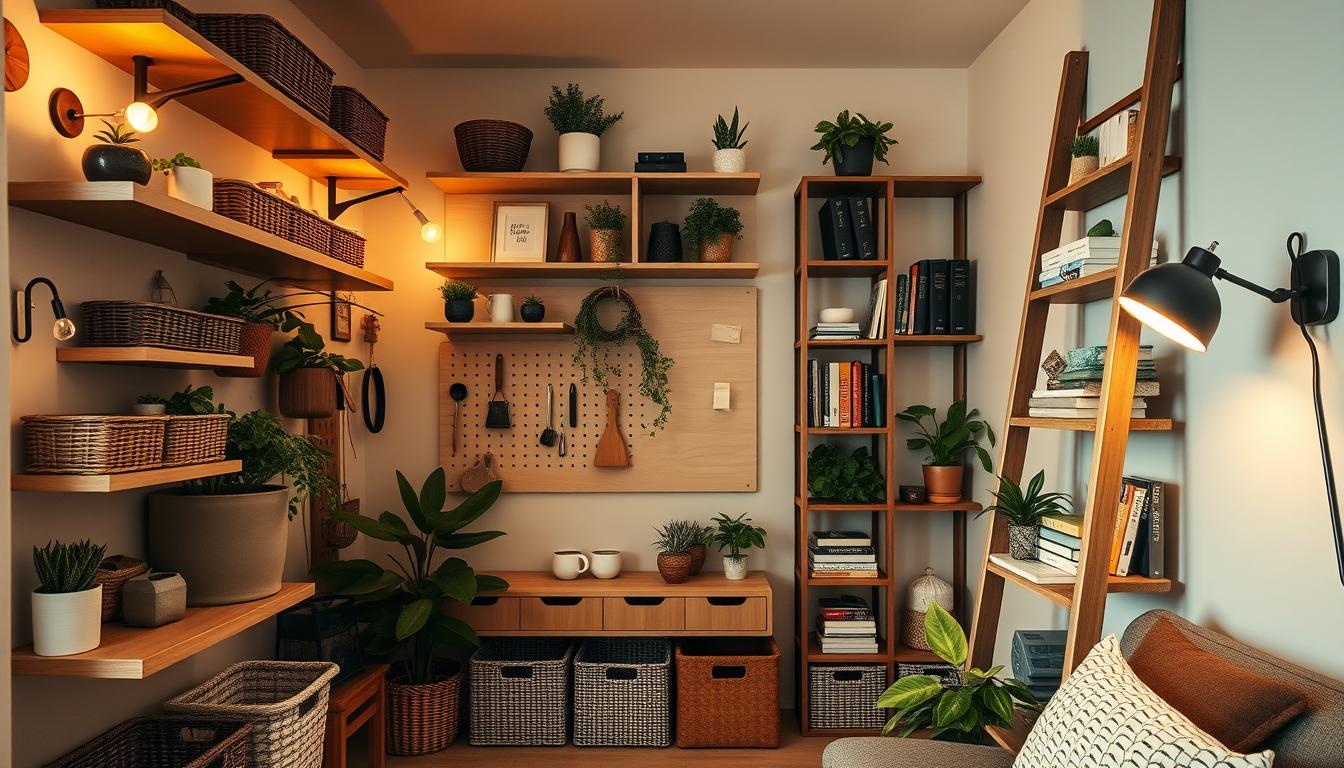
In small spaces, every inch matters. Maximizing storage space needs creativity and smart choices. Even the tightest corners can hide opportunities. Let’s explore three strategies to turn cramped areas into useful zones.
Hidden Storage Opportunities You’re Missing
Don’t overlook obvious spots. The area behind doors or under staircases is often unused. Install shelves in empty wall niches or use under-bed containers for seasonal items.
I’ve seen clients triple their closet space by adding slim sliding units behind existing wardrobes.
Multifunctional Furniture That Stores More
- Choose furniture with hidden compartments, like IKEA’s KALLAX storage cubes or ottomans with lids
- Bed frames with built-in drawers save floor space
- Expandable dining tables that adjust to guest sizes
Wall-Mounted Systems for Maximum Space Efficiency
Vertical storage is crucial. Pegboards let you hang tools and accessories, while over-the-door organizers free up floors. I suggest using floating shelves from brands like (Ikea) or modular systems from MUJI to create custom layouts.
For renters, adhesive-free solutions like Command brand hooks avoid damage. By combining these ideas, even 200 sq ft apartments become manageable. The goal isn’t just to store—it’s to curate only what you need, using every nook wisely.
Maintaining Your Organized Home: Creating Sustainable Systems
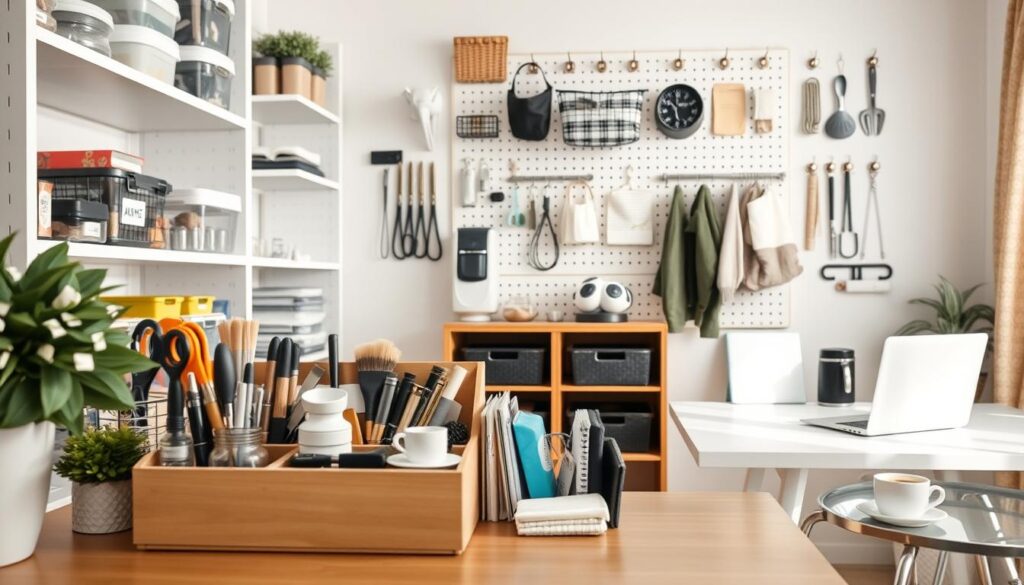
Organized home hacks aren’t just for cleaning up once. They need routines to keep spaces tidy. Begin with a daily reset: tidy up high-traffic spots like entryways and kitchens for 5–10 minutes. This stops clutter from building up.
- Weekly maintenance: Spend 20–30 minutes weekly on tasks like sorting mail, wiping surfaces, and restocking supplies.
- Seasonal reviews: Every 3 months, check your storage systems. Make changes as your lifestyle changes.
Home organizing works best when everyone helps. Teach family members to put things back where they belong. Here’s how to get everyone involved:
| Task | Frequency | Time |
|---|---|---|
| Quick tidy-up | Daily | 5–10 mins |
| Deep cleanup | Weekly | 20–30 mins |
| System audit | Seasonal | 1–2 hours |
“Maintenance is the silent hero of lasting order.”
Change your systems as your life does. Need a home office? Turn a closet into a supply zone. Got a new family member? Add labeled bins for their stuff. Being flexible keeps your home organized.
Small habits lead to big results. Focus on being consistent, not perfect. Even 5 minutes a day can stop chaos. Remember, organization is a journey, not a goal.
Conclusion: Transform Your Home and Life Through Thoughtful Organization
Decluttering tips and smart strategies do more than clean up rooms. They change how we live. By using the ideas from this guide, you’ve learned how to organize spaces like kitchens, bedrooms, and offices. This can make life easier, less stressful, and even healthier.
Studies show that messy spaces can make us feel tired. Imagine being able to find your keys or tools quickly. This saves time and boosts your energy. Sarah from Austin, for example, started with her pantry and soon her whole home felt more organized. She even noticed better focus at work.
Start small, like organizing a drawer or shelf. Use digital and paper systems to stay organized. Remember, decluttering is a process, not a one-time task. Keep track of what works for you, like daily tidying or monthly reviews. The aim is to create a space that supports your life, not a perfect magazine photo.
Every organized spot you create helps you live more intentionally. By focusing on good systems, you free up mental energy for important things. Begin with one area today and see how it improves your life. Your home and mind will appreciate it.




